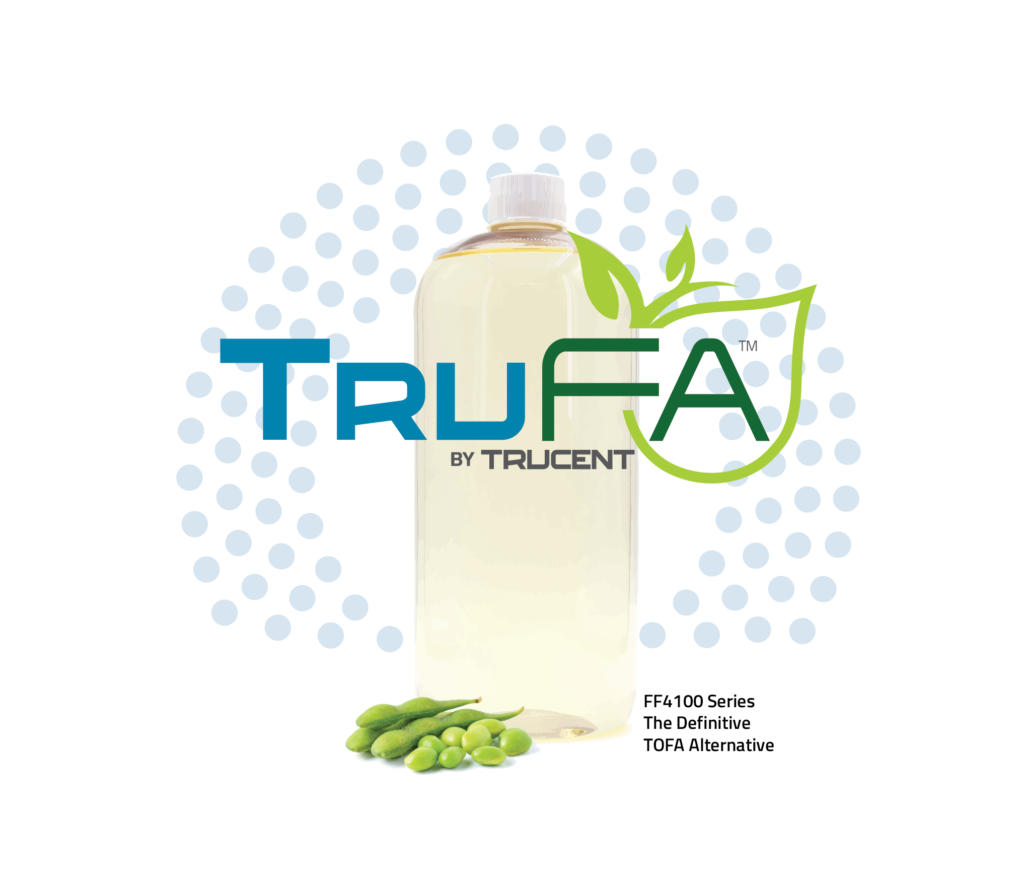
PRODUCT SPOTLIGHT

The Definitive TOFA Alternative
TRUCENT RENEWABLE CHEMICALS
Using Trucent’s proprietary biocatalytic splitting technology,
TruFA™ surpasses TOFA with unique benefits such as a low carbon footprint, plant-based seed oil sourcing, and a resilient supply chain. By isolating seed and vegetable oil triglycerides into essential fatty acids — stearate, oleate, and linoleate — TruFA exceeds industry standards.
TruFA closely mirrors the attributes of TOFA, providing a seamless transition for industries accustomed to the properties of traditional tall oil fatty acids.
Industrial
Solutions
Largest fleet of separation equipment with the CENTRASEP product line. Over 20 years of experience in purifying fluids used in industrial manufacturing processes.
Bioprocess
Solutions
Providing mechanical, service, and chemical solutions to extract coproducts and improve your agricultural operations.
Food & Beverage
Solutions
Food and beverage clarification technologies and services that protect your product and ensure you’re maximizing production.
Centrifuge Parts & Repair
Solutions
Centrifuge Parts and Repair (CPR) provides vital parts and repair services for the broader centrifuge industry. Brands serviced include Westfalia (GEA), Alfa Laval, Tetra Pak, and Seital (SPX). These services include complete machine rebuilds, bowl balancing, and repairs. In addition, CPR provides warranted remanufactured centrifuge equipment, OEM and aftermarket parts. Technical diagnostics and on-site services are part of the expertise CPR deliver to its customers.
Green Chemistry
Solutions
Trucent Renewable Chemicals combines the bio-based raw materials from our agricultural customers, technical separation capability from our industrial experience, and leading-edge chemical research. We manufacture environmentally-friendly plant-based chemicals. Our products are used to formulate a wide range of products, including personal care products, animal feed, surfactants, paints, coolants, and lubricants.

Client-Site Services
Committed to Service
With the largest fleet of separation technology, advanced engineering, and chemistry capability across a wide array of industries and experienced operations personnel throughout North America, you can count on us when you need us most.
- 9 Service Locations Across North America
- The Largest Fleet of Separation Technology
- Over 150 years of Fluid Separation Experience

Industrial Solutions
With increasingly narrow margins and tight deadlines, even a minor issue with cutting fluid or coolant can cause big headaches. We can help you find a better way to get more out of your existing centrifuges. If your equipment is overwhelmed, we can bring in temporary skid-mounted modules. Or we can create new custom filtration and separation solutions—and help you keep them running as smoothly as possible.
Bioprocess Solutions
The right equipment and supplies can ensure smooth bioprocess operations. We’ll help you maintain and program your existing centrifuge or we can develop new custom in-plant reclamation, recycling, and wastewater recovery solutions. Trucent supplies everything you need to meet your goals: chemistry for DCO extraction, custom syrup conditioners, high-speed disc stack centrifuges, and the know-how to get more out of what you’ve got.
Food & Beverage Solutions
Trucent furnishes and services centrifuges and other filtration technology throughout the food and beverage market: craft brewers, distillers, coffee & tea suppliers, juice makers, dairy farms, food processors, and more. We maintain and program all centrifuge makes and models or we can design and deliver a custom system, optimized to meet your needs.

Finding Opportunities in Every Field
We love to solve complex problems with graceful solutions. Share your biggest challenge, immerse us in your process, and let us find ways to help you increase separation efficiency, reduce waste, uncover new revenue streams, and become more sustainable.
Talk to an expert in your fieldSolutions
View All
Our solutions leverage our expertise in your industry and may combine a mix of services and products to ensure that your challenge is solved. Click view all to find a comprehensive solution for your industry.
Services
View All
Our services are our backbone. We have spent decades building teams and fleets of technology to ensure that our customers’ needs are met when and wherever they may be. Click view all to find a service that matches your unique challenge.
Products
View All
What began with a disc stack centrifuge has now grown into an entire toolbox of fluid separation technology to meet your needs. In addition to mechanical products, we have leveraged our years of expertise to develop chemistry for a variety of applications.








